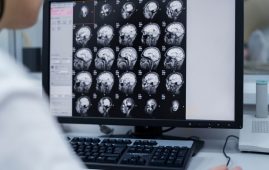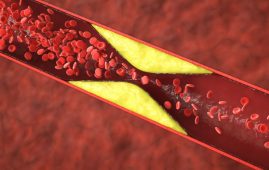

According to new research, neurons in the preoptic hypothalamus—the part of the brain that regulates sleep and body temperature—are rhythmically engaged during NREM sleep. According to a study published in Current Biology from the Perelman School of Medicine at the University of Pennsylvania, stress stimulates these brain cells out of turn, creating “microarousals” that disrupt sleep cycles and shorten the duration of sleep episodes.
While our bodies are at rest when we sleep, our minds remain quite active throughout the four stages of sleep. There are three stages of NREM sleep and one period of rapid eye movement (REM) sleep in each 90-minute sleep cycle.
Brain waves, heartbeat, and breathing all slow down during the first two stages of NREM sleep, as does body temperature. Spindles and K-complexes, which are brief bursts of activity responsible for processing outside stimuli as well as consolidating memory, are also included in stage two.
The third stage of the NREM sleep cycle is when the body releases growth hormone, which is necessary for bodily repair, immune system health, and memory enhancement.
Brain waves, known as delta waves, are larger during phase three. Memory creation, emotional processing, and brain development all depend on REM sleep, which occurs during this phase when dreaming generally occurs.
“When you have a bad night of sleep, you notice that your memory isn’t as good as it normally is, or your emotions are all over the place—but a bad night of sleep interrupts so many other processes throughout your body. This is even more heightened in individuals with stress-related sleep disorders,” said senior author, Shinjae Chung, Ph.D., an assistant professor of Neuroscience.
“It’s crucial to understand the biology driving the brain activity in these crucial stages of sleep, and how stimuli like stress can disrupt it, so that we might someday develop therapies to help individuals have more restful sleep that allows their brain to complete these important processes.”
The researchers studied the activity of glutamatergic neurons (VGLUT2) in the preoptic region (POA) of the hypothalamus of mice during natural sleep and discovered that glutamatergic neurons (VGLUT2) are rhythmically active during NREM sleep. VGLUT2 neurons were likewise found to be highest active during awake and less active during NREM and REM sleep.
VGLUT2 neurons were the only active neurons within the POA during microarousals in NREM sleep, and their signals began to increase in the time preceding a microarousal.
To establish that active VGLUT2 neurons were truly the origin of microarousal, the researchers activated VGLUT2 neurons in sleeping participants, which increased the number of microarousals and wakefulness instantly.
The researchers next exposed participants to a stressor, which increased awake time and microarousals while decreasing overall time spent in REM and NREM sleep, to demonstrate the link between stress and increased VGLUT2 neuron activation.
Researchers also discovered higher VGLUT2 neuron activity in stressed participants during NREM sleep. Furthermore, when VGLUT2 neurons were inhibited, microarousals during NREM sleep were reduced, and NREM sleep episodes were prolonged.
“The glutamatergic neurons in the hypothalamus give us a promising target for developing treatments for stress-related sleep disorders,” said first author, Jennifer Smith, a graduate researcher in Chung’s lab.
“Being able to reduce interruptions during the important stages of non-REM sleep by suppressing VGLUT2 activity would be groundbreaking for individuals struggling with disrupted sleep from disorders like insomnia or PTSD.”
For more information: Regulation of stress-induced sleep fragmentation by preoptic glutamatergic neurons, Current Biology (2023). DOI: 10.1016/j.cub.2023.11.035.
more recommended stories
 Children’s Health in the United States is Declining!
Children’s Health in the United States is Declining!Summary: A comprehensive analysis of U.S..
 Autoimmune Disorders: ADA2 as a Therapeutic Target
Autoimmune Disorders: ADA2 as a Therapeutic TargetAdenosine deaminase 2 (ADA2) has emerged.
 Is Prediabetes Reversible through Exercise?
Is Prediabetes Reversible through Exercise?150 Minutes of Weekly Exercise May.
 New Blood Cancer Model Unveils Drug Resistance
New Blood Cancer Model Unveils Drug ResistanceNew Lab Model Reveals Gene Mutation.
 Healthy Habits Slash Diverticulitis Risk in Half: Clinical Insights
Healthy Habits Slash Diverticulitis Risk in Half: Clinical InsightsHealthy Habits Slash Diverticulitis Risk in.
 Caffeine and SIDS: A New Prevention Theory
Caffeine and SIDS: A New Prevention TheoryFor the first time in decades,.
 Microbial Metabolites Reveal Health Insights
Microbial Metabolites Reveal Health InsightsThe human body is not just.
 Reelin and Cocaine Addiction: A Breakthrough Study
Reelin and Cocaine Addiction: A Breakthrough StudyA groundbreaking study from the University.
 Preeclampsia and Stroke Risk: Long-Term Effects
Preeclampsia and Stroke Risk: Long-Term EffectsPreeclampsia (PE) – a hypertensive disorder.
 Statins and Depression: No Added Benefit
Statins and Depression: No Added BenefitWhat Are Statins Used For? Statins.

Leave a Comment